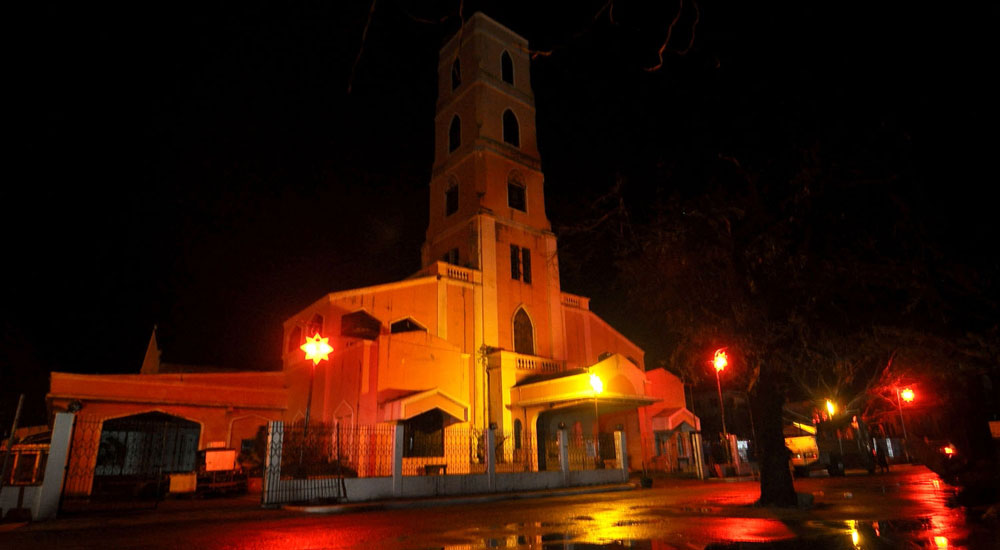
The nine-day “Simbang Gabi” and dawn Mass—a Filipino way of preparing for Christmas—endures, even in areas devastated by Supertyphoon “Yolanda.” INQUIRER FILE PHOTO
They may have lost their homes and their property—in fact, even their churches—but not their faith.
And so the nine-day “Simbang Gabi” and dawn Mass—a Filipino way of preparing for Christmas—endures, even in areas devastated by Supertyphoon “Yolanda.”
The presence of physical churches is not necessary, the president of the Catholic Bishops’ Conference of the Philippines (CBCP) said on Sunday.
“With or without roof, we can still worship because the Church is not just a building. The Church is the people,” Lingayen-Dagupan Archbishop Socrates Villegas told reporters.
The traditional dawn Mass starts Monday.
It is also called by some as the “Misa de Gallo,” or Mass of the Rooster, believed observed only in the Philippines, according to Church officials.
17th century
Villegas called on the people, even those living in typhoon-devastated areas, to attend the Masses.
“If the people gathered under the clear skies, we can still call it the Church. What is important at this time is the people,” Villegas said.
The dawn Mass has been observed in this mainly Roman Catholic country since the 17th century to benefit farmers who went to their fields early.
“You cannot say that you have no church to go to because God is always in your heart every time you stop and pray and become aware that God is in you,” Villegas said.
“God does not have office hours nor has He a building where you have to meet him. You can talk and meet God everywhere,” said the CBCP head.
Several churches were severely damaged or destroyed when Yolanda hammered cities and towns on Samar and Leyte islands on Nov. 8. One of them was the Church of the Immaculate Concepcion in Guiuan, Eastern Samar, one of the oldest churches in the country and considered a heritage site.
Villegas said that even if the churches were damaged by the typhoon, some of the materials used in Masses, “like wine and books,” were spared.
Much to thank for
Nursing her month-old baby Nielson at an evacuation center in Leyte’s Tacloban City, Joan Oseñares, 27, said she looked forward to attending the Misa de Gallo at the Sto. Nino Parish Church.
Oseñares vowed to complete the nine-day ritual even if Yolanda had taken her house away.
Janet Palacio, 34, said Obseñares, her friend, did not want to miss the Mass that she woke up early Sunday, thinking it was the start of the ritual.
Blushing, Obseñares said she had “more than enough to thank for” because their lives were spared by Yolanda’s wrath.
Need to thank God
Obseñares shared with Palacio and the latter’s six children her place on the platform of an athletic room at the Leyte Sports Complex.
Palacio, five months pregnant with her seventh child, said she would also attend the Misa de Gallo to thank God for her family’s survival.
Obseñares has another purpose for attending the Mass.
She said she had been attending the pre-Christmas Day Masses for years because she was wishing for the return of her siblings and relatives who are now living in Metro Manila.
“I was just a little girl when they left. I don’t remember their faces anymore. I wish they would come home soon,” she said.
No birthday cake
Dennis Capaycapay, 38, would like to thank God that he has a daughter like Denise Mae, who celebrated her fourth birthday on Sunday.
Capaycapay, who is rebuilding his house with materials scavenged from the debris, and his wife, Mae, sang “Happy Birthday” to their child.
They also lit a candle despite not having a cake to put it on.
“We have no money, no belongings and our Christmas might not be merry, but we will move on,” he said.
Originally posted: 9:27 pm | Sunday, December 15th, 2013
Related stories
Tacloban to adjust curfew for Simbang Gabi